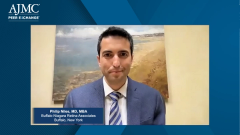
Approaching Treatment of Wet AMD and DME With Anti-VEGF Agents
Philip Niles, MD, MBA, leads a discussion on treatment approaches that are utilized with anti-VEGF agents in wet AMD and DME, including payer considerations for approaches such as treat and extend.
Episodes in this series

Jim Kenney, RPh, MBA: What is the treat and extend approach, and how does that differ from labeled dosing?
Philip Niles, MD, MBA: That’s a great question that is supercritical to our conversation today. When we look at a medication that gets approved through an FDA process and goes through a clinical trial, usually those trials use something called a fixed-dosing interval, where say every month or every 2 months, or every 3 months, a patient receives a dose of the medication. It’s very challenging for patients to maintain fixed-dosing intervals in the real world outside of clinical trials and even within clinical trials sometimes. What treat and extend is, is a bit more of a flexible approach that allows doctors or physicians to extend the amount of time between visits. For instance, if you saw a patient who’s doing great every 4 weeks on a certain medication, maybe you would try 5 or 6 weeks instead. And if they’re doing great at 5 or 6 weeks, maybe you’d try 7 or 8 weeks, and gradually go longer and longer between visits. I would say it’s the preferred approach among most retina specialists today. And it’s interesting because it veers off from the FDA on-label approvals of how the medication was tested in trials, but it’s by far the most common usage of it.
Nicholas G. Anderson, MD: I agree with Dr. Niles, treat and extend has certainly become the predominant treatment protocol among specialists across the country, and probably around the world. It’s the protocol that I use. Essentially it’s a compromise. As Dr. Niles mentioned, it’s easier to adhere to for patients, and frankly at the physician level, we’re all swamped with patients right now. Anything we can do to increase that treatment interval is certainly beneficial to the patients, it unclogs our clinics a bit, but it is a compromise. If you look at any of the real-world data, if you look at any of the treat and extend protocol studies, it is very effective. It’s a very safe protocol. None of those studies have ever matched the outcomes in the original monthly treatment protocols found in the FDA approval trials. So it is a compromise, but I think it’s a compromise that patients and physicians are willing to accept. As long as we’re closely monitoring the patient, I do think it can be a safe and effective treatment.
Jim Kenney, RPh, MBA: Are health plans pushing back and trying to drive this treat and extend approach, implementing quantity limits or dosing restrictions on these products to try to get the most value out of these products that do have a potential extended dosing interval?
Kevin U. Stephens, Sr., JD, MD: That’s another very tough and good question by the way. I don’t know why you’re giving me all these tough questions. The thing is the benefit and the problem are both in the same bucket, because clearly if you treat and extend, that’s better in terms of reduction of costs. Because in a year, if you think about it, you have 52 weeks in the year; if you go every 4 weeks, then that’s 10, 12, 13 visits. If you go every 5 weeks, that’s 10. So as you spread it out, you get fewer treatments. They are, again, very costly. The bad side of that is that it’s very hard to be as objective as we would like for it to be. There is somewhat of what we call a subjective component to it. And that requires a lot of patience and leniency, and we just have to communicate and collaborate. Typically when we have these types of issues, we do what we call a peer-to-peer review. So if the provider wants to do something that is not as regimented per say, then we’ll talk through it. Typically the provider will do a peer to peer with the medical director, review the case. Then you can get to some type of soft spot where everyone can agree to make sure that it’s appropriate utilization. And of course, with the patient, I think it’s always motivational if you say it doses every 4 weeks, 5 weeks, 6, 7 weeks, and they feel better, and it’s a win-win for everyone. So yes, it’s a very tough space though.
Nicholas G. Anderson, MD: I think flexibility is the key. There are no patients who are exactly like any other patients, and especially in diabetic macular edema [DME] and exudative macular degeneration, we see an incredible degree of variability between patients. I have a lot of patients who I treat on a Q [every] 3-month basis, but I have an awful lot of patients who I still treat on a monthly basis. They may have been treated on a monthly basis for 5 years or longer now. And every time I try to space that patient out to 6 weeks, we see a recurrence of fluid, we see the vision getting worse. The patient calls me and says, “Hey, it’s not lasting.” Then I have to bring them back to 4 weeks. So it is just a very wide spectrum of disease phenotype here in that some patients are going to need Q4 week therapy. Some patients, I extend them out to Q3 months, and then a lot of patients after they’ve been stable for 3 months, I may actually discontinue their therapy and continue to follow them very closely in the office without injecting. But there’s such a broad spectrum, it’s very hard to either implement a policy or follow a policy that’s designed for the average patient. Perhaps the average patient only needs treatment every 6 to 8 weeks, but that doesn’t mean that every patient can go 6 to 8 weeks. And so I really think flexibility is the key.
Kevin U. Stephens, Sr., JD, MD: I think Dr. Anderson brings up a very good point. One of the things health plans are really zooming in on is things that we can do something about. And one of the things that we can do something about, particularly in retinopathy and diabetics, we can help them to control their blood sugar. We can help them to have exercise and healthier diets and those type of things. We know that if the primary disease state is diabetes or some inflammatory condition, immunosuppression, or whatever is there, if we can help the patient to get motivated and get those under control, that can potentially have a positive impact upon the treatment of their eye disease. So we have a lot of programs. We have a continuous glucose monitor that we can put on some patients where they can monitor blood sugar every 5 minutes. We have dieticians and nutritionists who help them figure out to stay away from things like processed foods that are filled with nitrates and inflammatory type of agents and go to more omega-3 fatty acids, like fish and those kind of things. So there are a lot of things we can collaborate on with the provider. One thing I wanted to make clear is that we are on the same side, and we have the same goals in mind. We want healthier patients, we want lower costs, and then of course, we look at outcomes. I think we can collaborate on many components here to help further the process.
Philip Niles, MD, MBA: I completely agree. Dr. Stephens, you have been taking a lot of the tough questions, and I think it’s good time to give you guys [UnitedHealthcare] a little credit. Earlier this year, you guys proposed the policy of limiting patient injections to 9 times per year, then after further discussions with those in our field, you said, “Hey, you know what, let’s change it. I don’t think that’s really going to work for people.” You really handled that well. I give you guys a lot of credit for collaborating with the retina community and making that work. To add on to what Dr. Anderson said, our imaging in retina has gotten so good now that we can say with a pretty high degree of confidence, this patient’s going to need this treatment once a month, or this patient can get away with going out a little bit longer. It’s really so individually specific to each patient, and I feel like as a retina care community, we can do a pretty good job with our diagnostics of knowing which patients need what, and that’s also very critical to better allocating resources.
Nicholas G. Anderson, MD: I certainly echo what Dr. Stephens and Dr. Niles said in terms of collaboration. Our practice is very proactive in working with the commercial payers to look at the policies, look at the protocols and make sure that we understand where everyone’s coming from. I would encourage every payer group in every region, as well as every practice, to be very proactive. I think every practice needs to know the medical affairs officer for each payer in their region and needs to invite them to come meet with the physicians. Very frequently the medical affairs director for that specific payer, they may be a cardiologist, they may be a gynecologist, they may be an ophthalmologist. Obviously the medical director isn’t an expert in every single field, and as ophthalmologists, we’ve somewhat, unfortunately, segregated ourselves from the wider medical field. So I think it’s absolutely critical that we all try to meet at least once a year to talk about how we’re providing care for our patients, what can we do better? The health care providers have a lot of good clinical information. The payers have a lot of clinical data that they can share with us. That’s very important to work together and really be on a first-name basis with the medical director, for the payers, and have that shared goal in mind.
Philip Niles, MD, MBA: Just a quick question for Dr. Stephens or Dr. Anderson. If you don’t have that relationship with your payer community, what would be your first step to starting to build those bonds?
Kevin U. Stephens, Sr., JD, MD: I can take the first stab at it. First, I would just go to their website, and they typically will list all of the medical directors, and then you can see who, well, insurance companies are very complicated, let me just say that. You have prior authorization, you have utilization management, you have case management, you have disease management, you have pharmacy and the pharmacist. Most of us have a pharmacist who manages our formulary and works with all this. It depends on the issue you’re having. If it’s approval authorization of a drug, then that’s a prior authorization thing. If it’s a case management thing, it’s a procedure, it’s imaging, they have all these different things. Typically, 1 medical director in the smaller plans may do all of it, but in the larger plans, you have different medical directors who are specialists in that area. For instance in radiology, you have a radiologist, and in DME and those kind of things, you have people who are very proficient in those areas, which helps in terms of utilization, the standards of care, and doing the best thing so that we can work together.
Jim Kenney, RPh, MBA: Dr. Anderson, you hit on a great point. Collaboration is critical here. I think you can identify that you very efficiently and effectively can assess patients and determine what type of dosing schedule they need to get. When you sit behind the desk in a formulary management setting, and you’re reading the clinical data on a drug, and it has X number of doses, and the plans are trying to say, “How do we manage so that we don’t have excess dosages or inappropriate use?” You start off with a basic policy that ties to that label, but if it needs to be adjusted and we need to make exceptions to that, that conversation is critical. So I think to answer your question, Dr. Niles, it’s reaching out to the plans, formulary management teams, clinical pharmacists, whoever it might be, and identifying those places within the guidelines or the prior authorizations that need to be revisited.
The plans do that on a regular basis. They look to see how many of these referrals are we getting? How many prior authorizations that we are rejecting are we approving on a second request? They’re not looking to have extra burden on the system as well. We’re trying to find those points of weakness, if you will, where there is inappropriate use or excessive use that maybe can be adjusted, or alternative therapies that may be a little bit less expensive. I think that conversation with the experts is critical to help us understand where are we missing the boat here if we’ve got something wrong? We’re not looking to make your life difficult or the patient’s life difficult, but we also have a huge budget to try to manage, and there are so many different drugs in the mix. Sometimes we get it wrong. So any feedback you can provide and any collaboration there would be excellent.
Transcript Edited for Clarity
Newsletter
Stay ahead of policy, cost, and value—subscribe to AJMC for expert insights at the intersection of clinical care and health economics.






































